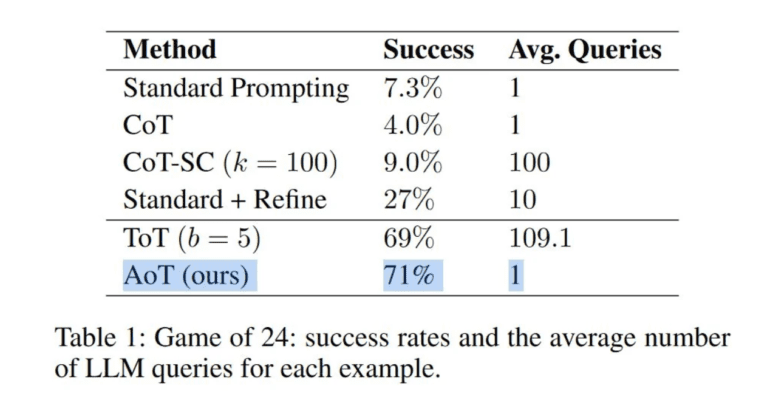TL;DR:
- Microsoft introduced “Algorithm of Thoughts” (AoT) to enhance AI reasoning capabilities.
- AoT employs in-context learning, allowing models to solve problems with efficiency.
- Models imitate classic programming algorithms, improving problem-solving steps.
- AoT mirrors human thought processes, enhancing intermediate reasoning.
- The technique aids AI in explaining reasoning, leading to improved learning dynamics.
- AoT aligns with the trend towards more explainable AI models.
- Industry experts emphasize the need for further AI advancements to achieve true human-like reasoning.
Main AI News:
In a bid to propel artificial intelligence (AI) into new dimensions of sophistication, Microsoft researchers have unveiled a groundbreaking training technique known as the “Algorithm of Thoughts” (AoT). This novel approach aims to elevate the efficiency and human-like reasoning capabilities of large language models (LLMs) such as ChatGPT. The tech giant’s pursuit of imbuing AI with human-like acumen underscores the drive to bridge the gap between machine and human cognition.
The realm of machine learning excels at discerning correlations, yet it often falters in grasping causation—an insight articulated by Chris Anderson, Chief Product Officer at Doppl.ai, a pioneering generative AI company. In an email exchange with Lifewire, Anderson noted that AI’s inability to expound on its reasoning distinguishes it from human cognition. Unlike AI, humans possess a profound, symbolic comprehension of the world, rooted in axiomatic wisdom and empirical learning.
Microsoft’s latest research paper posits that the AoT technique possesses transformative potential, steering language models toward more efficient problem-solving trajectories. “In-context learning” forms the cornerstone of this approach, enabling models to methodically analyze diverse solutions within a structured framework. By affording LLMs the capability to navigate the steps of problem-solving with precision, the Algorithm of Thought method empowers models to emulate the behaviors of classical programming algorithms. It allows models to backtrack to prior computed steps, facilitating a seamless resumption from those points—a dynamic akin to a computer science student mastering algorithms by iteratively solving examples.
This sophisticated approach mirrors the human cognitive process, wherein individuals deconstruct problems into a sequence of manageable queries. Hong Zhou, Director of the Intelligent Services Group & AI R&D at Wiley, emphasized the analogy, suggesting that the “tree of thoughts” that humans employ assists LLMs in intermediate reasoning. This decision tree modality, which AoT harnesses through a single query, enables LLMs to traverse complex problem spaces effectively.
While LLMs such as ChatGPT have demonstrated considerable prowess, they remain a work in progress. Further strides, akin to the AoT breakthrough, could manifest in the form of explainable AI—a milestone wherein AIs articulate their rationale, engendering a symbiotic learning dynamic with humans. As AI models expand in sophistication, the prospect of misconceptions and errors eluding human detection becomes conceivable.
Evan Macmillan, CEO of Gridspace, forecasts that emergent algorithmic methodologies like AoT will augment the quality and production of LLMs. He highlights the growth potential unlocked by AI models assimilating intricate feedback and on-the-job learning, thereby enhancing their efficiency and performance.
Microsoft’s pioneering strides arrive against the backdrop of mounting speculation about AI’s convergence with human-like reasoning. In March, Microsoft’s research team introduced a paper titled “Sparks of Artificial General Intelligence: Early Experiments with GPT-4,” underscoring GPT-4’s indications of “artificial general intelligence” (AGI). Though AoT marks a substantial advancement, Raghu Ravinutala, CEO of yellow.ai, offers a tempered perspective, asserting that human-like intelligence in AI remains a distant goal. He suggests that progress hinges on multifaceted advancements across AI research domains to bridge the chasm between AI’s current capabilities and true human-level reasoning—an evolution defined by a “complex understanding.”
Conclusion:
Microsoft’s Algorithm of Thoughts breakthrough marks a significant stride in AI development. By enabling models to emulate human-like reasoning and improve problem-solving efficiency, AoT contributes to the growing trend of explainable AI. While this innovation holds promise, the path to achieving true human-level reasoning in AI necessitates continued advancements across various domains. The market can anticipate heightened AI capabilities and a closer human-AI symbiotic relationship as technologies like AoT pave the way for a more sophisticated AI landscape.

